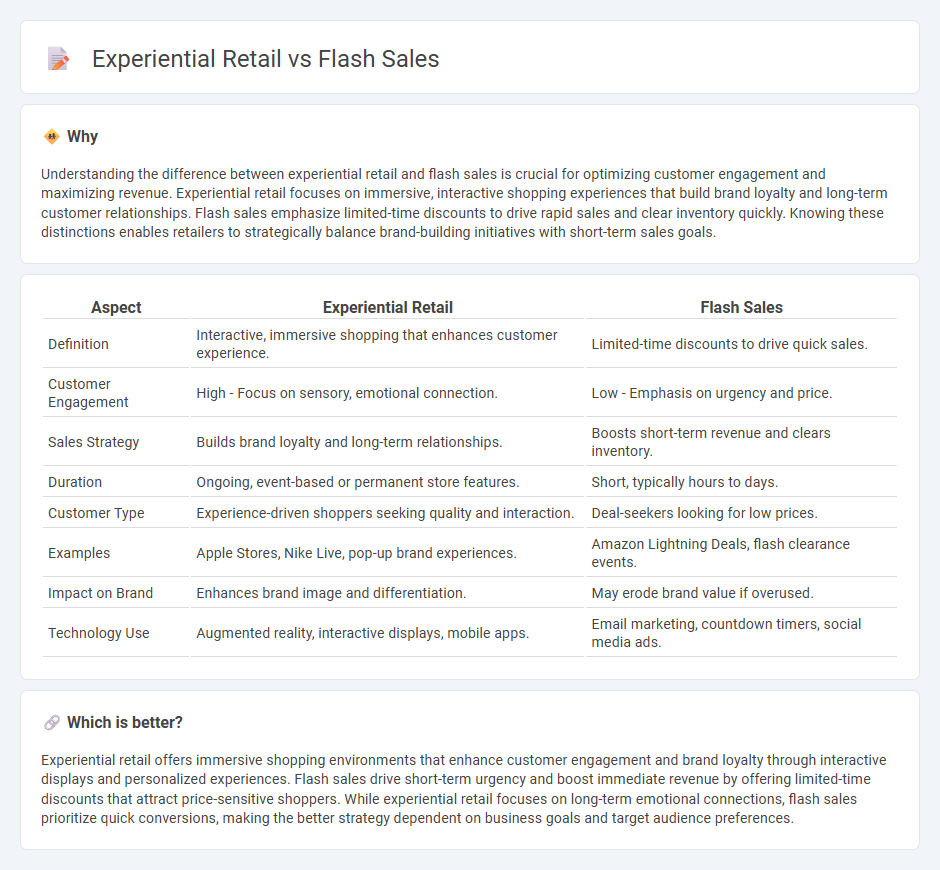
Experiential retail transforms traditional shopping by creating immersive, sensory-rich environments that engage customers beyond mere transactions. Flash sales drive rapid purchase decisions through limited-time offers, leveraging urgency and exclusivity to boost short-term sales volume. Explore how blending experiential retail with flash sales strategies can maximize customer engagement and revenue.
Why it is important
Understanding the difference between experiential retail and flash sales is crucial for optimizing customer engagement and maximizing revenue. Experiential retail focuses on immersive, interactive shopping experiences that build brand loyalty and long-term customer relationships. Flash sales emphasize limited-time discounts to drive rapid sales and clear inventory quickly. Knowing these distinctions enables retailers to strategically balance brand-building initiatives with short-term sales goals.
Comparison Table
| Aspect | Experiential Retail | Flash Sales |
|---|---|---|
| Definition | Interactive, immersive shopping that enhances customer experience. | Limited-time discounts to drive quick sales. |
| Customer Engagement | High - Focus on sensory, emotional connection. | Low - Emphasis on urgency and price. |
| Sales Strategy | Builds brand loyalty and long-term relationships. | Boosts short-term revenue and clears inventory. |
| Duration | Ongoing, event-based or permanent store features. | Short, typically hours to days. |
| Customer Type | Experience-driven shoppers seeking quality and interaction. | Deal-seekers looking for low prices. |
| Examples | Apple Stores, Nike Live, pop-up brand experiences. | Amazon Lightning Deals, flash clearance events. |
| Impact on Brand | Enhances brand image and differentiation. | May erode brand value if overused. |
| Technology Use | Augmented reality, interactive displays, mobile apps. | Email marketing, countdown timers, social media ads. |
Which is better?
Experiential retail offers immersive shopping environments that enhance customer engagement and brand loyalty through interactive displays and personalized experiences. Flash sales drive short-term urgency and boost immediate revenue by offering limited-time discounts that attract price-sensitive shoppers. While experiential retail focuses on long-term emotional connections, flash sales prioritize quick conversions, making the better strategy dependent on business goals and target audience preferences.
Connection
Experiential retail leverages immersive and interactive store environments to engage customers, driving impulse purchases that complement the urgency of flash sales. Flash sales create a sense of scarcity and excitement, encouraging immediate buying behavior that experiential retail amplifies through memorable, sensory-driven shopping experiences. Combining these strategies enhances consumer engagement and boosts short-term revenue by blending emotional connection with time-limited offers.
Key Terms
Urgency
Flash sales drive urgency through limited-time discounts and scarce inventory, compelling immediate purchases and boosting short-term revenue. Experiential retail creates urgency by offering immersive, memorable brand interactions that encourage quick decision-making to avoid missing unique experiences. Explore how combining these strategies can maximize consumer engagement and sales efficiency.
Immersion
Flash sales generate urgency through limited-time discounts, driving quick consumer purchases. Experiential retail emphasizes immersive brand engagement, creating memorable in-store interactions that foster deeper emotional connections. Explore how immersive retail strategies transform customer loyalty beyond traditional flash sale tactics.
Customer engagement
Flash sales generate excitement through limited-time offers, driving immediate spikes in customer engagement and boosting short-term sales. Experiential retail fosters deeper connections by creating immersive, interactive environments that encourage brand loyalty and prolonged visits. Explore how combining these strategies can maximize customer engagement and enhance retail success.
Source and External Links
What Is A Flash Sale? How to Run One and Examples (2025) - A flash sale is a time-limited discount or promotion allowing merchants to sell many products at steep discounts, leveraging shopper FOMO for quick sales but with risks like margin erosion and attracting non-loyal customers.
What are flash sales? - Flash sales are short-period discount promotions with limited quantities that prompt impulse purchases and can effectively clear excess or out-of-season inventory to lower operating costs.
Flash Sales Guide: Expert Tips, Ideas & Examples - Flash sales usually last from a few hours up to 72 hours, offering deep discounts, but must be planned carefully to avoid risks such as lower profitability, slower order processing, and damaging brand reputation.
 dowidth.com
dowidth.com